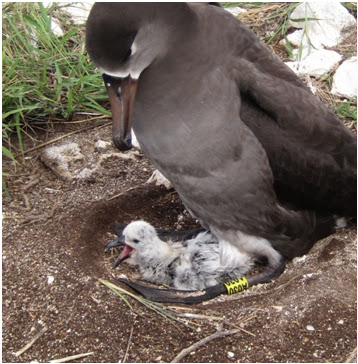Aloha kakou! Internet has been really, really slow this week (and non-existent most of the time), so we can't post things as often as we'd like. Facebook is about the only thing that loads when its that slow. I will upload small fuzzy versions of pictures so they have time to upload....so please be patient!
Our big news: the black-footed albatross chicks started hatching this week!
 |
| First ka'upu chick on Tern Island this year!!! |
Range of temperature: 66 to 78ºF. Only 0.88” rainfall accumulated this week. Average wind velocity was 11.7 knots, with gusts to 23.3 kts on 12Jan11.
We did not get the tremendous winds experienced on Midway and Laysan this week -- they had winds over 60 knots! -- although it was enough to stop bird monitoring for several days. (Birds can be injured if flushed when the wind is >20 knots.) A large south swell made using the (south-facing) dock unsafe for small boats, and resulted in no Kahana stop on their way back to Honolulu.... so that means we couldn't send back our boat parts for repair.
ʻĀ wāwae (red-footed boobies) hunker down in 20 knot wind this week.
In addition, we can't have any planes fly in if there is any moisture on the runway, so we likely won't be having too many flights in before March -- and then, since there are so many sooty terns, our flights are limited as well. Ah, the vagaries of island logistics!!! It's all good, though, because we do, in fact, live on a remote island. If it was easy to get to, it wouldn't be remote. :-)
 |
| Dan Rapp playing guitar on the back lanai. Music is an important part of island life. |
We have a special project on Tern. Helly Hansen (she prefers to be called 'Hansen'), a Laysan albatross that has been studying mechanics under Paula's direction, wants to pursue a technical degree in small engine repair. There are very few albatross with college degrees of any kind, so we would really like to encourage her. Because she doesn't have much money -- few of the albatross really do -- we are looking for scholarship opportunities for Hansen.
 |
Helly Hansen waiting patiently in the boathouse for her next lesson.
Helly Hansen assisting in removal of the lower units from the SAFEboat outboards. |
Finally, NEWS FROM MIDWAY ISLAND: The first short-tailed albatross chick (EVER!) was born on Midway Island this week!!! This is truly phenomenal news. This bubble-gum beaked species was considered extinct in the 1950's, after it had been hunted out for its feathers. It made a come-back, but only has nested on two islands in Japan -- making it extremely vulnerable to true extinction. Having a new breeding site buys the short-tailed albatross a lot of insurance, in case one or the other gets wiped out (by natural disaster, disease or whatever). Check out some of the info online -- A very interesting creature!
 |
| First short-tailed albatross chick born in the NWHI!!! Photo at Midway, taken by Pete Leary. |





